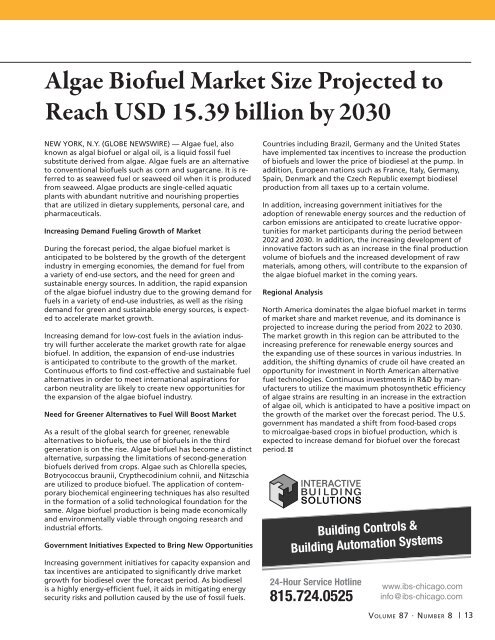CEAC-2022-08-August
You also want an ePaper? Increase the reach of your titles
YUMPU automatically turns print PDFs into web optimized ePapers that Google loves.
Algae Biofuel Market Size Projected to<br />
Reach USD 15.39 billion by 2030<br />
NEW YORK, N.Y. (GLOBE NEWSWIRE) — Algae fuel, also<br />
known as algal biofuel or algal oil, is a liquid fossil fuel<br />
substitute derived from algae. Algae fuels are an alternative<br />
to conventional biofuels such as corn and sugarcane. It is referred<br />
to as seaweed fuel or seaweed oil when it is produced<br />
from seaweed. Algae products are single-celled aquatic<br />
plants with abundant nutritive and nourishing properties<br />
that are utilized in dietary supplements, personal care, and<br />
pharmaceuticals.<br />
Increasing Demand Fueling Growth of Market<br />
During the forecast period, the algae biofuel market is<br />
anticipated to be bolstered by the growth of the detergent<br />
industry in emerging economies, the demand for fuel from<br />
a variety of end-use sectors, and the need for green and<br />
sustainable energy sources. In addition, the rapid expansion<br />
of the algae biofuel industry due to the growing demand for<br />
fuels in a variety of end-use industries, as well as the rising<br />
demand for green and sustainable energy sources, is expected<br />
to accelerate market growth.<br />
Increasing demand for low-cost fuels in the aviation industry<br />
will further accelerate the market growth rate for algae<br />
biofuel. In addition, the expansion of end-use industries<br />
is anticipated to contribute to the growth of the market.<br />
Continuous efforts to find cost-effective and sustainable fuel<br />
alternatives in order to meet international aspirations for<br />
carbon neutrality are likely to create new opportunities for<br />
the expansion of the algae biofuel industry.<br />
Need for Greener Alternatives to Fuel Will Boost Market<br />
As a result of the global search for greener, renewable<br />
alternatives to biofuels, the use of biofuels in the third<br />
generation is on the rise. Algae biofuel has become a distinct<br />
alternative, surpassing the limitations of second-generation<br />
biofuels derived from crops. Algae such as Chlorella species,<br />
Botryococcus braunii, Crypthecodinium cohnii, and Nitzschia<br />
are utilized to produce biofuel. The application of contemporary<br />
biochemical engineering techniques has also resulted<br />
in the formation of a solid technological foundation for the<br />
same. Algae biofuel production is being made economically<br />
and environmentally viable through ongoing research and<br />
industrial efforts.<br />
Government Initiatives Expected to Bring New Opportunities<br />
Increasing government initiatives for capacity expansion and<br />
tax incentives are anticipated to significantly drive market<br />
growth for biodiesel over the forecast period. As biodiesel<br />
is a highly energy-efficient fuel, it aids in mitigating energy<br />
security risks and pollution caused by the use of fossil fuels.<br />
Countries including Brazil, Germany and the United States<br />
have implemented tax incentives to increase the production<br />
of biofuels and lower the price of biodiesel at the pump. In<br />
addition, European nations such as France, Italy, Germany,<br />
Spain, Denmark and the Czech Republic exempt biodiesel<br />
production from all taxes up to a certain volume.<br />
In addition, increasing government initiatives for the<br />
adoption of renewable energy sources and the reduction of<br />
carbon emissions are anticipated to create lucrative opportunities<br />
for market participants during the period between<br />
<strong>2022</strong> and 2030. In addition, the increasing development of<br />
innovative factors such as an increase in the final production<br />
volume of biofuels and the increased development of raw<br />
materials, among others, will contribute to the expansion of<br />
the algae biofuel market in the coming years.<br />
Regional Analysis<br />
North America dominates the algae biofuel market in terms<br />
of market share and market revenue, and its dominance is<br />
projected to increase during the period from <strong>2022</strong> to 2030.<br />
The market growth in this region can be attributed to the<br />
increasing preference for renewable energy sources and<br />
the expanding use of these sources in various industries. In<br />
addition, the shifting dynamics of crude oil have created an<br />
opportunity for investment in North American alternative<br />
fuel technologies. Continuous investments in R&D by manufacturers<br />
to utilize the maximum photosynthetic efficiency<br />
of algae strains are resulting in an increase in the extraction<br />
of algae oil, which is anticipated to have a positive impact on<br />
the growth of the market over the forecast period. The U.S.<br />
government has mandated a shift from food-based crops<br />
to microalgae-based crops in biofuel production, which is<br />
expected to increase demand for biofuel over the forecast<br />
period.<br />
Building Controls &<br />
Building Automation Systems<br />
24-Hour Service Hotline<br />
815.724.0525<br />
www.ibs-chicago.com<br />
info@ibs-chicago.com<br />
Volume 87 · Number 8 | 13

















